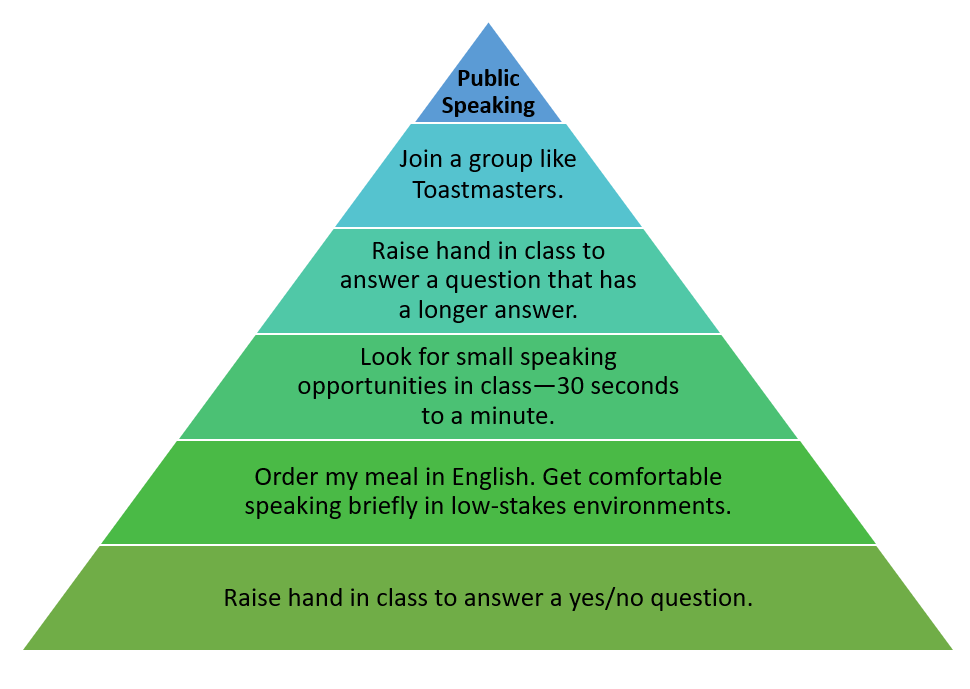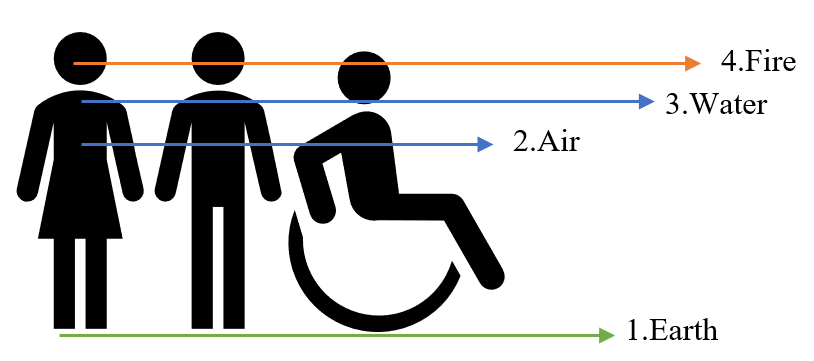Reducing Learner Anxiety With 5 Mindfulness Techniques
by Saghar Leslie Naghib

Many multilingual learners of English face stress and/or
anxiety, not just about learning a new language but also about their personal
narratives—the aspects that rest beneath the surface of what they might
demonstrably show. Though adopting a mindfulness practice in the classroom can
take place at any point, doing so at the beginning of a new year provides an
ideal opportunity to develop new habits and implement practical techniques that
can leave a lasting impact on one’s learning experience. As an English language
lecturer and conflict resolution practitioner, and with the perspective that
pedagogy and practice inform each other, I suggest approaching the issue of
student stress and anxiety with five mindfulness techniques:
- Gradual exposure
- “I feel” statements
- Four elements of stress reduction (Shapiro,
2012)
- Self-scan, awareness, and containment
- Reframing automatic negative thoughts (ANTs;
Amen, 2015)
Note: It is well worth noting
the adage, “One cannot pour from an empty cup.” Check in with yourselves first
and make sure your proverbial cup is filled—enough that you can pour out for
your students. (Of course, this directive is easier written than done, in
practice.)
Because stoicism is often both a geographical and
academic cultural norm, prioritizing and modeling practical methods for mental
health inclusivity supports a classroom environment that truly teaches the
whole person.
The framework for these techniques should be led
with the following motto: Progress over perfection. Normalizing conversations
about stress and anxiety in the classroom promotes and sustains a learning
environment where students prioritize their well-being in relation to learning.
It is most effective to introduce the following techniques as early as the first
few weeks of your academic context, but it is beneficial at any time.
For each technique, I've provided guiding
objectives and principles so you can adapt the techniques to your audience and
level.
Technique 1. Gradual Exposure
Guiding Objective: The
purpose of gradual exposure is to incrementally become comfortable with
experiences that cause discomfort and resulting stress or anxiety.
Approach
-
Have students identify one task or aspect of the
course or class that would typically cause them direct or indirect stress or
anxiety.
-
Then, have students brainstorm as many achievable
microgoals as possible—microgoals that would support them with stronger
feelings of ease along with the stressful event. Map the microgoals in order
from least stressful to most stressful, with the final stressful event at the
top.
-
Teach students that the goal is to make progress,
and if they were only able to surpass their first microgoal, even that would be
progress.
-
Provide an example (see Figure 1).

Figure 1. Gradual exposure example.
Technique 2. “I feel” Statements
Guiding Objectives: “I
feel” statements establish ownership of one’s feelings and consequently
initiate personal accountability. The goal is to normalize talking about how
students feel in relation to stress and/or anxiety, explore why they might feel
that way, and support an environment where they express what they need.
 Approach
Approach
-
Establish a regular practice of “checking in”
with how students feel about a class-related task, happenstance, or event.
-
Consider having an “I feel” poster in your
classroom or a section in your course syllabus.
-
Teach how to effectively express “I feel”
statements using a template similar to the one shown in Figure 2.
-
Provide examples:
Example 1
-
I feel anxious because I don’t think my language ability is good
enough to deliver a presentation.
-
When I speak in
public at my level of ability, I stutter and even forget what I am supposed to
say.
-
I need more practice
and to feel comfortable making mistakes as I grow.
Example 2
-
I feel frustrated because I studied very hard for my reading
comprehension/oral communication exam, and I earned a grade lower than I
expected.
-
When I see my grade
lower than where I think my progress is, I feel like giving up.
-
I need to practice
having a growth mindset, to understand that progress is not linear, and to
believe that I am going to eventually achieve my goals.
Technique 3. Four Elements of Stress Reduction (Shapiro,
2012)
Guiding Objectives: Shapiro’s (2012) four elements of stress reduction—earth, air,
water, and fire—promotes the practice of keeping your stress levels within a
window of tolerance by implementing four grounding exercises that redirect
attention outward and inward. The intention is to, in each part of your body
(see Figure 3), work through moments where you feel flooded by feelings of
stress tied to a class-related event through acknowledgement, acceptance, and
release.
Approach

Figure 3. Anatomical view of Shapiro’s (2012) four
elements of stress reduction.
-
In the early weeks of an academic session,
introduce students to the concept of self-regulation and emphasize the
importance of checking in with oneself.
-
Underscore the principle that self-checks are a
form of self-respect and self-care—both being characteristics of resilient and
motivated lifelong learners.
-
Teach students how to do Shapiro’s four elements
using an example like the following:
Example
Teacher: Acknowledge stressful
feelings and self-regulate by doing as many of the four steps as you
can:
1. Earth: Get grounded
by connecting with the earth. This could be taking your shoes off and taking a
barefoot walk, even if it is brief. Or, getting grounded could be tapping your
feet to a rhythm that is comforting. Even bolder, ground yourself by putting on
your favorite song and dancing. The idea is to move.
2. Air: Breathe by
putting your left hand on your heart and your right hand on your stomach and
inhaling for four counts and exhaling for seven counts. The idea is to slow
down your nerves, and connecting with your breath is most effective.
3. Water: Taste
something that will liven up or refresh you. This could look like drinking a
cup of comforting tea or sucking on a peppermint candy.
4. Fire: Imagine your
safe and happy place. As you pull up this image in your mind, place yourself in
it and think about how you feel when experiencing your comforting space. Allow
yourself to dwell on that thought for a minute before repositioning yourself in
your circumstance or environment.
Technique 4. Self-Scan, Awareness, and Containment
Guiding Objectives: Psychiatrist Bessel van der Kolk (2014) is known for saying “The
body keeps the score.” A body that keeps the score, a dysregulated body, is
often unmotivated to learn because it is under duress. By teaching students the
practice of drawing awareness to how one is feeling, they can then learn how to
direct feelings to an appropriate place in one’s experience—a form of
containment. Cultivating an atmosphere where acknowledging how students feel in
the classroom as a regular component of the day’s agenda brings balance to the
era of “leave your feelings at the door” in education and academia.
Approach
-
Be in tune with your class and make it a
conscientious point to take the social-emotional pulse of your students as they
enter. This might look like making eye-contact and addressing students by name
as you welcome them to class. Look for verbal and nonverbal cues to determine
whether this mindfulness technique is appropriate for the day.
-
Consider adopting a mindfulness warm-up practice
in the first 10 minutes of class where you walk students through a body scan.
Here is an example:
Example
Teacher: Good morning. Welcome
to class. I invite you to participate in a brief warm-up before we dive into
our lesson today. Participation is optional. If you choose not to participate
in our warm-up, take these next 5 minutes to center (focus) yourself ahead of
our time together.
Self-Scan and
Awareness
Are we ready?
-
Close your eyes in 5, 4, 3, 2, 1.
-
Ease (become comfortable) into your seat and into
this classroom.
-
We’ll begin by becoming aware of our breath.
-
At your own pace, take three breaths. Inhale
(breathe in) and slowly exhale (breathe out). [Wait 5 breaths.]
-
Become aware of any tension or discomfort you
might feel. What is weighing you down today? What might be occupying your
thoughts?
Containment
-
As you become aware of how you are feeling,
acknowledge yourself and direct those feelings to where you want them to go.
This could be in a container on a shelf or even in box that you dump in an
ocean.
-
Remind yourself that you can always revisit what
is bothering you or occupying your thoughts at any time, but that you are
choosing to acknowledge and contain them for our class time together.
Closing
-
Once you have directed your feelings to where you
want them to go during our time together, take three breaths at your own pace.
[Wait 5 breaths]
-
Now, open your eyes in 5, 4, 3, 2, 1.
Technique 5. Reframing Automatic Negative Thoughts (ANTs)
Guiding Objectives: Conceptually designed from the work of Beck et al. (1979) and
later coined and further developed by psychiatrist Amen (2015), the term
“automatic negative thoughts” (ANTs) refers to the proliferation of one’s
long-held automatic negative beliefs. Students often curate narratives of what
they might have been told their strengths or weaknesses are in a subject or
academic history and use those frames for how they position themselves in class
and how they see themselves as independent language learners. Whether the
negative thought be categorized as catastrophizing, labeling, mind reading, or
blaming—just to name a few ANTs categories—the thought presents a cognitive
distortion that needs reframing so students can progress. The objective is
first to help train the mind to identify ANTs and afterwards, to reframe them.
Approach
-
Teach students the concept that our brains
believe what we tell them and, like anything else, the brain becomes what we
feed it. So, it is best to feed it a great diet.
-
Briefly walk students through a reframing ANTs
exercise like the following:
Teacher: We often have ANTs
that can influence how we view ourselves and even learn and grow. For me, your
professor, this is what my ANT sounded like: “I’m not good at math. I’ve never
been good at math. I’ll never be good at math. So, I’ll stick to what I’m good
at—reading and writing.” For someone learning a new language, an ANT might
sound like this: “Others laugh at my pronunciation, so it is better if I stay
quiet. If I don’t speak up, I will never be humiliated.” ANTs are like
jokes—they only have a little bit of truth to them. ANTs are not the whole picture we want to believe.
Practice
-
First, take 1–2 minutes and write down one or
more ANTs that often come up for you while in our class. You are the only
person who is going to see your ANTs.
-
Then once you have your ANTs down, answer these
questions about them:
-
My ANTs are 100% true all the time. ❏ Yes ❏
No
-
My ANTs define who I am. ❏ Yes ❏ No
-
My ANTs are the reality I want. ❏ Yes ❏
No
-
Chances are all your answers to the checklist
above are NO!
-
Finally, write down what I like to call “positive
encouraging thoughts” (PETs). PETs counter your ANTs. Your PETs are what you want to think about and believe. For me, my PET sounds
like this: “Math can often be difficult for many people. Some concepts are
easier than others for me to learn. Like other things that I learn, practice
and progress are what I choose to believe I am capable of.”
-
For you, a PET for pronunciation skills while
learning a new language might sound like this: “Learning and speaking an
additional language proves how capable I am. I have language abilities that
others may not have, and I am unique. My accent is part of who I am. Other
people’s ability to understand me is what is important, not having perfect pronunciation. What people think about
me is their problem—not mine.”
-
Repeat this process daily to avoid ANTs and keep
PETs!
Conclusion
Often, teachers and students alike enter the
classroom with conscious and unconscious assumptions of each other and the year
or semester ahead. We must remember that our language learners enter our
classrooms with an entire history of which we do not know, and stress and
anxiety may very well be exacerbated by classroom happenings. The task at hand
is clear—to provide multilingual learners of English with the knowledge and
tools necessary to achieve learning gains and, hopefully, establish an
environment in which they have ease and joy doing so.
References
Amen, D. G. (2015). Change your brain,
change your life: The breakthrough program for conquering anxiety, depression,
obsessiveness, lack of focus, anger, and memory problems. Harmony
Books.
Beck, A. T., Rush, J., Shaw, B., & Emery,
G. (1979). Cognitive therapy of depression. Guilford
Press.
Shapiro, E. (2012). 4 elements exercises
for stress reduction (earth -air -water -fire).https://emdrfoundation.org/toolkit/four-elements.pdf
van der Kolk, B. (2014). The body keeps
the score: Mind, brain and body in the transformation of trauma.
Penguin Books.
Dr. Saghar Leslie Naghib, a second generation Persian American and Miami native, is a senior lecturer of English language with Duke Kunshan University’s Language and Culture Center and an advocate for normalizing the role of a positive mental health approach in education and academia.